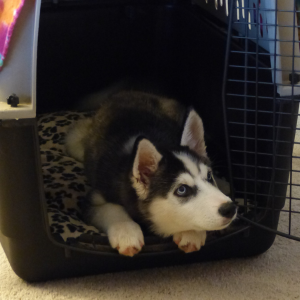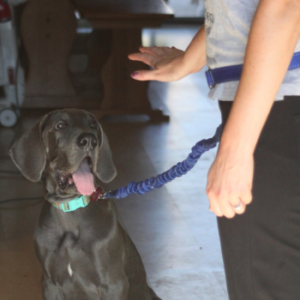7 Mistakes That Can Ruin Your Puppy’s Behavior
(And How to Avoid Them)
Dogs are naturally curious and love to explore their surroundings. Unfortunately, this can lead to them getting into things they shouldn’t—especially as puppies. Creating a safe home environment for your pup is crucial, and it’s never too late to puppy-proof your space. Even if you’ve had your dog for years, regularly checking for potential hazards can prevent accidents and keep your furry friend safe.
Follow these 10 easy steps to puppy-proof your home and gain peace of mind!
Reference Sections:
- Comforting Fear Can Create Aggression
- Giving Your Puppy Too Much Space
- Letting Your Puppy Stray
- Coming Whenever Your Puppy Cries
- Not Using Corrections
- Not Being Consistent
- Not Giving Them a Purpose
1. Comforting Fear Can Create Aggression
Puppies aren’t born aggressive. What appears to be aggression often starts as fear, anxiety, or overexcitement. Many owners unknowingly reinforce these feelings by comforting their puppy in moments of distress. Petting, picking up, or speaking softly to a scared puppy might feel nurturing—but to your pup, it signals that fear is the right response.
✅ What to do: Reward calm behavior. Teach your puppy that you are in control and there’s no need to panic. Dogs take cues from your energy, tone, and body language.
💡Pro Tip! A calm, confident approach helps prevent fear-based behaviors from escalating into aggression.


2. Giving Too Much Freedom Too Soon
Allowing a puppy to roam the whole house can quickly undermine potty training and create chaos. Puppies thrive in small, safe spaces. They’re used to confined areas, which help build healthy routines.
✅ What to do: Use a crate or pen, and let your puppy out for structured potty and play times. Create a cozy space with a bed, water, and a rotation of toys.
💡 Pro Tip! A timer helps establish a consistent potty routine and builds trust.
3. Letting Your Puppy Stray
Young puppies naturally follow you. But if you let them wander off, they’ll learn that they don’t need to pay attention to you.
Loose-leash walking starts now – even indoors. Using a hands-free leash teaches your pup to stay near you and see you as their leader.
✅ What to do: Practice short “follow me” sessions. Reinforce proximity and direction.
💡 Pro tip! This sets the stage for future leash manners and the heel command.


4. Coming Whenever Your Puppy Cries
It’s natural to want to comfort your puppy when they cry in the crate—but running to them every time teaches them that crying gets results. Puppies are smart, and they’ll quickly learn that whining = attention.
✅ What to do: Pause before responding. Wait until your puppy has a moment of silence before going to them. This reinforces quiet behavior. Make sure their needs are met (potty, hunger, comfort), then allow them time to settle independently.
💡 Pro Tip! Use a calming bedtime routine and a chew toy in the crate to help them wind down. This helps with crate training a puppy and teaches self-soothing.
5. Not Using Corrections
Positive reinforcement is powerful—but that doesn’t mean zero boundaries. Puppies need structure to understand right from wrong. Ignoring all unwanted behavior can create confusion and reinforce bad habits.
✅ What to do: Redirect unwanted behaviors (like biting or jumping) with a firm “uh uh” or a gentle interruption, then offer a better behavior to reward. For example, if they jump, ask for a sit instead.
💡 Pro Tip! Use consistent, calm corrections—not punishments. This teaches your puppy that good things come from following rules. It’s one of the most effective puppy training tips out there.


6. Not Being Consistent
If one day jumping gets attention and the next day it gets ignored, your puppy won’t know what’s expected. Inconsistency creates anxiety, slows learning, and can lead to behavior problems.
✅ What to do: Create a consistent schedule for feeding, potty breaks, training, and crate time. Make sure everyone in the household uses the same commands and rewards.
💡 Pro Tip! Post a visible “puppy training cheat sheet” with rules, cue words, and your puppy’s daily routine. This helps everyone stay on the same page.
7. Not Giving Them a Purpose
When puppies get bored, they create their own entertainment—usually in the form of chaos. Chewing shoes, barking at shadows, or digging up the yard are all signs your pup is craving more structure and stimulation. Dogs are wired to have a job—even if it’s a simple one.
✅ What to do: Build purpose into your puppy’s day through training, structured play, and enrichment activities. Teach basic commands, use puzzle feeders, rotate toys, or assign small tasks like carrying a toy during walks. These help satisfy natural instincts and reduce problem behaviors.
💡 Pro Tip! Puppies need both physical exercise and mental stimulation. Add enrichment games and short training sessions into your daily puppy training routine to keep your pup happy, focused, and well-behaved.

With the right guidance, you can sidestep common pitfalls and set your puppy up for success. Stay consistent, start good habits early, and give your pup meaningful ways to learn and grow. You’ve got this—enjoy the journey!
Need help with your pup?
We understand that balancing everything on your plate can be overwhelming. Let us take some of the pressure off. Reach out to us for all your training needs, and let’s make life with your dog even better!

